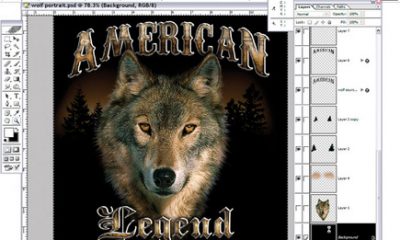Digital Printing
Published
18 years agoon
Being a Red Sox fan, I generally don’t have nice things to say about the New York Yankees. But the ever-colorful Yankee manager and coach, Yogi Berra, may have said it best: “You can observe a lot just by watching.” Let’s be honest. Being a good observer is only part of the equation. The real key to observing is not only to learn from mistakes (your own and those of others), but also to put yourself in better position for the future.
I now have ten years of experience under my belt in following the wide-format-graphics industry. If my experience in this industry has taught me anything, it is that change is inevitable. For all of us who participate in this quickly evolving graphics market, it’s clear that our ability to change is necessary in order to move forward successfully. But to do so, it is important to remember from where we came and how the market ended up where it is today.
In the beginning
The market for digitally produced wide-format graphics is really no more than 15 years old. But in that decade and a half, we have seen tremendous market growth, rapid adoption of printing capabilities, and technologies, products, and suppliers come and go. During all of this, we have also seen many shotgun approaches to the market—both by suppliers and by users.
In my home, the shotgun approach also is known as the Women’s Shoe Theory. It usually takes the scattering of no fewer than two dozen pairs of my wife’s shoes before she finds a pair that hits the mark. It is a reasonable approach, but a process that usually leaves me scratching my head. The same can be said about taking this approach in the graphics industry.
The nearly $6.4 billion US market for digitally printed wide-format graphics developed from the local—and later on, regional—demand for customized advertising. There were many successes, to be sure. But with those successes came increased competition, numerous new entrants, several disruptive technologies, and many low-cost suppliers. And a number of these suppliers took a bit of a shotgun approach to the developing market, rapidly throwing out new products of all types in hopes that some of them would catch on.
So does the shotgun approach work? Well, yes it often does—eventually. But it is rarely the most effective approach to product development and success. For suppliers, I am sure that your customers (both distributors and print shops) would prefer to see fewer product SKUs and not as many new, superfluous products. Shops are pushing back on their distributors to carry immediately available inventory while distributors are trying to streamline an increasingly complex and costly task of managing inventories of supplies.
That said, print shops also are looking at ways to differentiate their product offerings. Entering and competing in a commoditized market is something that few successful businesses would choose to do. The simple truth is that the majority of wide-format-inkjet graphics produced today could be made with a more limited number of printers and supplies. While there is always an opportunity for new applications, most shops appear skeptical of trying new things in fear of product failure or falling short of customer expectations.
The road map to today
Every year, we at Web Consulting update our annual profile on the US traditional signage and graphics screen-printing industries. In addition to counting the number of shops in specific categories, we track the adoption rates of wide-format inkjets. The information we collect is always interesting.
For some print shops, bringing new inkjet technology in house has been more challenging than expected. There is quite a bit to learn to maximize the capabilities and benefits of these systems, and the learning curve can be tricky. The digital world speaks a slightly different language than traditional screen printers are accustomed to. But in this global economy with relatively low barriers to enter the graphics market, the time to speak one graphics language has never been greater.
For example, understanding the needs and benefits of inkjet technology and digitally printed applications is more critical now than ever before. Some shops resell graphics they outsource from other printers in order to evaluate their real opportunity before investing in an inkjet printer. Is this an uncommon practice? No, not at all. Web Consulting estimates that approximately 12-15% of all graphics produced on wide-format inkjets and sold in the US have been outsourced. And if you think it’s all still printed in the US, then you are mistaken. There is a growing trend in which shops are outsourcing certain print jobs overseas to China, Korea, and other countries. There are quality-control issues associated with this trend, but the fact that this outsourcing is occurring could have an impact on your company. It really depends on the business model you follow.
A look in the mirror
If your business is that of a printer, then yes, you may need to worry about low-cost providers and increased competition. But if your business model is that of a graphics supplier—a provider of advertising or signage solutions—then perhaps there is less need to worry. Printing services can quickly become commodities. And wide-format inkjet printing is really no different.
Dare I ask how often a customer specifically requests a rolled-up piece of 2-mil, self-adhesive, high-performance cast vinyl with a company logo and some promotional message printed on a piezo-based solvent inkjet printer? I’m sure you can order that online today from some print shop in China. But that isn’t what customers want. Instead, they ask for someone to wrap a delivery van or public bus. That’s an application. So is a Zamboni wrap, ski-gondola wraps, or perhaps wraps on airline-ticket kiosks and ATMs. An installed street-pole banner is an application. The printing could be done anywhere in the world today. But it would be difficult for that print shop in Korea to install the graphic with a cherry picker in Kansas City. In today’s solution- and applications-based graphics market, being the problem solver and solution provider will become more and more important. In fact, it will be critical to success.
Is the future inkjet world really flat?
Gleaning the long-term impact of inkjet printers is sort of like the Spaghetti Test I once used to determine whether my pasta was cooked completely. It involved throwing a noodle at the wall —if it stuck, the pasta was perfectly al-dente. While I found this to be a fun and adequate approach, my wife urged me to come up with another method after our kitchen was repainted. It may seem a stretch, but the adoption and usage of flatbed inkjet printers has occurred in much the same manner as my now-abandoned spaghetti test.
Flatbed inkjet (mostly UV-curable today) printers are now being adopted in the US at a very rapid rate. This move has been driven by the commercial availability of solvent and UV-curable systems at price points below $75,000. It is interesting, however, that while there has been a three-year shift away from aqueous inkjet technology, there has been nothing unusual or erratic in application trends in what is actually being produced by wide-format-graphics providers with the new machines.
The point is that the production of graphics by new and old techniques alike will continue to be scrutinized. But there is room for all these techniques in the US graphics market, just as there are many types of customers who may be best served by cut vinyl, screen-printed, or UV-inkjet-printed graphics. The market is changing and will continue to change—there is no doubt about that. As Yogi Berra said, “The future ain’t what it used to be.”

Subscribe

Magazine
Get the most important news
and business ideas from Screenprinting Magazine.
Most Popular
-

 Art, Ad, or Alchemy1 month ago
Art, Ad, or Alchemy1 month agoF&I Printing Is Everywhere!
-

 Case Studies1 month ago
Case Studies1 month agoHigh-Density Inks Help Specialty Printing Take Center Stage
-

 Andy MacDougall1 month ago
Andy MacDougall1 month agoFunctional and Industrial Printing is EVERYWHERE!
-

 Columns2 weeks ago
Columns2 weeks ago8 Marketing Mistakes Not to Make When Promoting Your Screen Printing Services Online
-

 Editor's Note2 weeks ago
Editor's Note2 weeks agoLivin’ the High Life
-

 Thomas Trimingham2 months ago
Thomas Trimingham2 months ago“Magic” Marketing for Screen Printing Shops
-

 Marshall Atkinson2 weeks ago
Marshall Atkinson2 weeks agoHow to Create a Winning Culture in Your Screen-Printing Business
-

 News & Trends1 month ago
News & Trends1 month agoWhat Are ZALPHAS and How Can You Serve Them in Your Print Business?






